

I'm off to to visit Sterling Rope in Biddeford, Maine, a long five hour drive from Saratoga Springs, upstate New York where I am staying with family. Just like the fuel in this rental car and the nylon reinforcement cord in the tyres, climbing ropes are made from oil. In fact that nylon reinforcement cord in tyres, nylon 6, is the same material that climbing ropes are made from. I wonder if ropes will see a price increase.
It's also a trip down my memory freeway as I traverse Boston on highway 495 and head north. Boston is where I met Gabriella and where my son Xavier was born. I spent two years in total in New England, publishing two Rockfax guidebooks, climbing on the granite and ice of New Hampshire and Maine, and making lots of good friends.
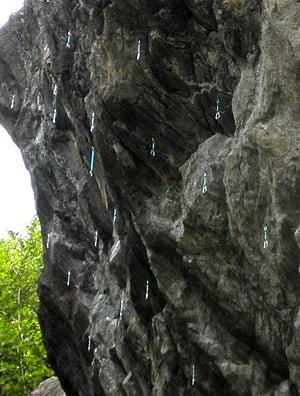
That was back in 1993 around the same time Sterling Rope was founded by Carolyn Brodsky and her husband Willy Crear. It was a bold and risky move, as bold as some of the runout routes on nearby Cathedral Ledge. The US had two domestic rope manufacturers, New England Ropes and Blue Water, and the European behemoths of Mammut and Beal already had a dominant share of the market. But a successful move, as over the last 18 years Sterling Rope have established themselves as a major player in the climbing rope market in the US, and are now making inroads into Europe.
They entered the UK market last year after a deal was signed by Paul Niland, Sterling Ropes' International Sales Manager and Si Berry of Beta Climbing Designs. They also advertise on UKClimbing.com, so as I was nearby, in USA terms at least, I thought it fitting to pay a visit to say hello and have a look at how ropes are made.
My guides were Paul and Jim Ewing, Sterling Ropes Product Engineer who I remember from the Northeast climbing scene, both are excellent climbers and as keen as ever and talk is immediately of a controversy at a nearby sport crag, Shagg Crag, where some locals have placed hundreds of insitu quickdraws or permadraws making this pristine overhanging granite crag look like a christmas tree heavy with decorations. Fortunately most of them have been removed.
Sterling employ around 50 people in their Biddeford factory and produce rope for the safety, rescue and the working at height markets, for boating (floating ropes!) and they even supply many fire departments with personal rescue rigs as well as their mainstay, climbing ropes.
So how are climbing ropes made? Jim and Paul gave me the grand tour which I have documented below.
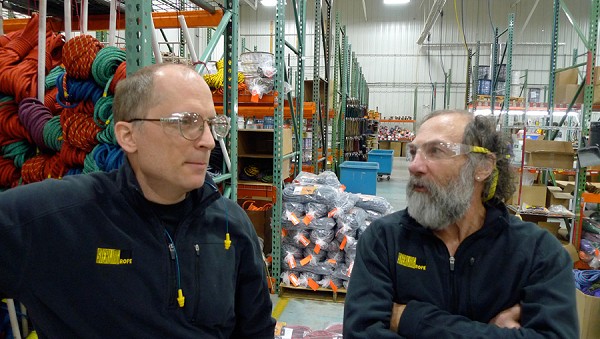
Rope Manufacture at Sterling Rope
It's been a long time since climbing ropes were made from manila or hemp. Back then climbing ropes were weak and didn't stretch much. They were good enough to hold body weight but back in the sepia days of our pioneers, a fall was unthinkable and body breaking.
Today ropes are made out of nylon 6 which was developed by Wallace Carothers at the Dupont Institute in 1935. So a big thank you to Mr. Carothers. Wallace, a ground-breaking chemist, was plagued by mental health problems and thoughts that he was an underachiever, committing suicide by taking cyanide in 1937.
All dynamic climbing ropes begin as nylon filaments (polyamide 6 industrial filaments), made from oil by a Swiss company, Nexis Fibres, in Latvia. These nylon filaments as mentioned are also used in tyre manufacture to reinforce the rubber. (Learn more: www.nexisfibers.com)
Nylon is the material of choice as it has strength, elasticity and memory, all important properties of a climbing rope. When you fall the rope has to stretch to cushion the fall, and it must absorb energy from the force of falling so that force is not transferred to our bodies which would injure us. The memory in the nylon is what returns the rope's elasticity; without it the rope would stretch and lose its dynamic quality, its stretchiness, and it would essentially become a static rope which would be lethal if you took a fall. Other important properties include good resistance to abrasion, UV, heat and chemicals.
There are two components to a climbing rope: the inner core and the outer sheath. The core provides the force-absorbing part of the rope and accounts for up to 80% of a climbing ropes' strength. The finely weaved sheath protects the core from abrasion and being cut, especially over sharp rock edges. The sheath also protects the core from penetration by dirt and sharp particles and adds some strength and shock absorption as well.
The Core
Six thin nylon filaments from Nexis Fibres are twisted around each other to make one thicker yarn. It is this twisting which holds the yarn together and gives the strands their mechanical springiness. At Sterling Rope when these initial yarns are formed they also treat the strands with a dry treatment and lubricant.
Three of these yarns are then twisted around each other by left hand and right hand twists, or S and Z twists, to make a core strand - which if you've ever cut a rope or unravelled the end you will be familiar with - and these core strands are spun on spools to create a core package.
This twisting of the core strands determines the elongation and strength of the rope, the twisting can vary depending on the type of rope and its intended use.
At Sterling Rope the next treatment is a proprietary conditioning process called Thermo-Dynamic Balancing TM. The core packages are unravelled into skeins which are loose coils of the core strands. The skeins are placed in a huge autoclave or pressure cooker and steam is driven through the core strands, making them shrink considerably. This heat stabilisation reduces shrinking of the rope, increases stretch or elongation, limits sheath slippage and helps maintain elongation properties.
The skeins are then unravelled again and spun back onto core packages ready for the final process.
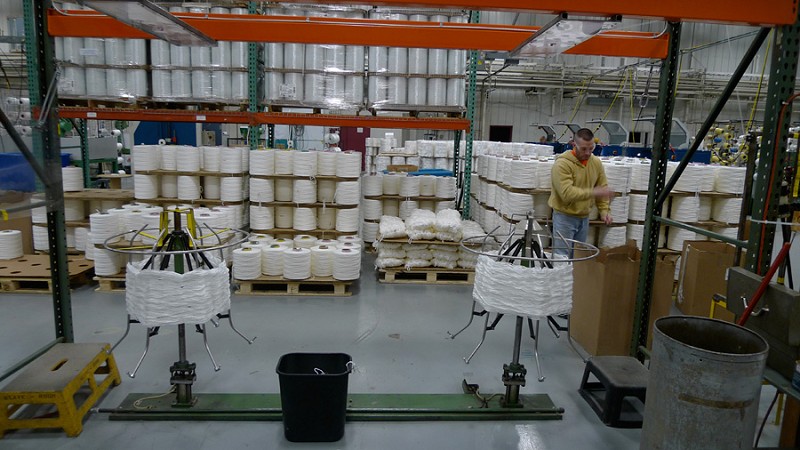
The Sheath
Meanwhile the sheath yarn is prepared. The Sheath yarn is a similar nylon to the core, a polyamide 6 industrial yarn, except it is dyed to give climbing ropes their attractive colour design.
The sheath yarn passes through a quality control process, checking for knots, and is wound onto braider bobbins in exact lengths ready for the final braiding of the sheath yarn around the core strands.
VIDEO: Around The Maypole - Bringing The Sheath and The Core Together
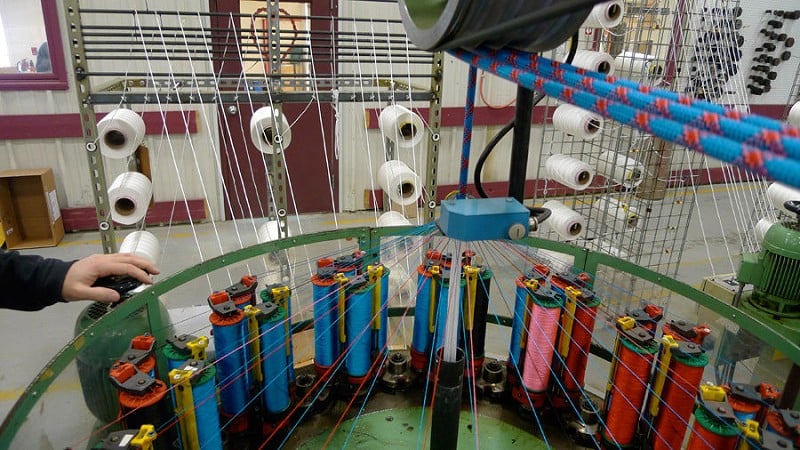
This final braiding is done on a Maypole braiding machine - you'll see why it is called a Maypole machine if you watch the video. 48 bobbins are loaded up with coloured sheath yarn and 11 core packages of core strands. This machine twists the 11 core strands to form the core of the rope and the core comes up the Maypole machine (the core is the Maypole) and the 48 bobbins of sheath yarn rotate in several directions and braid the sheath under tension around the core. Again the twist levels can be varied as can the angle that the sheath is braided on the core to give the characteristics of the finished rope. The finished rope feeds out into a huge plastic container.
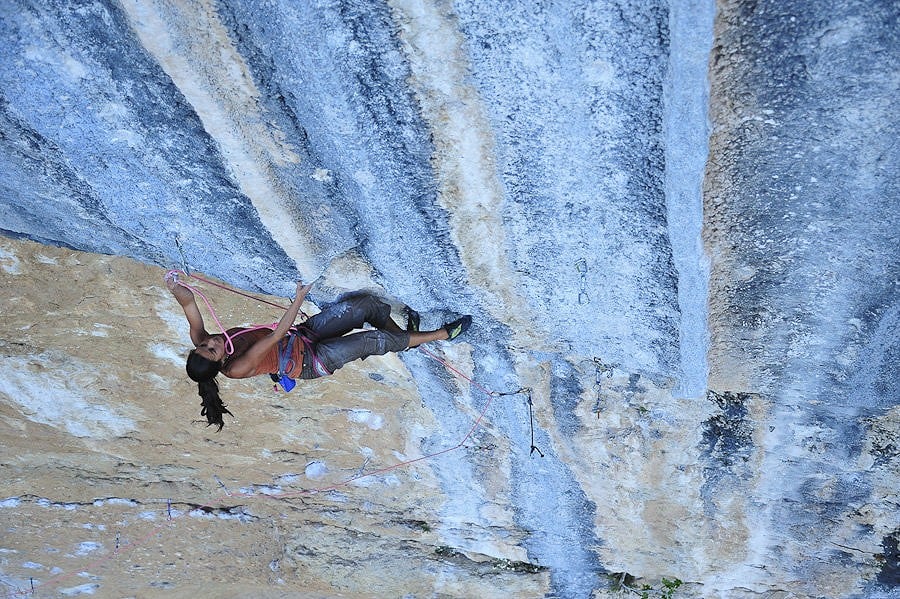
Finishing

Quality Control
At each stage of the process there is a human controlling the machines to make sure the required twists and tensions are constant and controlled, and each stage is recorded. This information is recorded in the 'lot number' and you will find it on the hangtag of your Sterling Rope. As is standard in all climbing rope manufacture, Sterling Rope conform to a Quality Management System certified to ISO 9001 Standards and third party certification to UIAA (Union Internationale des Associations d' Alpinisme) and CE (Certified for Europe) standards in the USA by Underwriters Laboratories, a UIAA approved testing facility.
Rope Recycling
Like most outdoor companies, and rope companies, Sterling are making efforts to reduce their impact on the environment. They recycle any excess ropes and yarns, as well as paper, plastic and cardboard. Packaging has been reduced and in 2006 they implemented a rope recycling program where you can return any old ropes, of whatever brand, and receive a 20% voucher off your next Sterling rope purchase. After collecting the retired ropes, Sterling consolidate them into containers and send them to their recycling partner who re-pelletizes the nylon. From there the nylon is made into things like carpet fuzz, coat hangers, and all types of everyday household items.
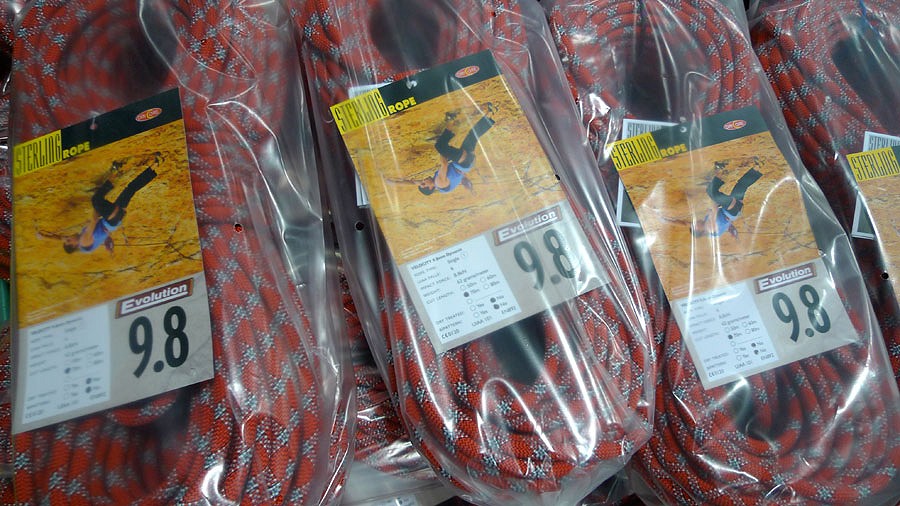
We do tend to put blind faith in our gear, seeing in the flesh the care and the passion that goes in to the design and manufacture of ropes, whilst not making me a bolder climber, was very reassuring. Thank you to all at Sterling Rope in Maine for showing me around. However, once that rope is bought, its care is up to you, treat it with respect.
Here are a few rope care and useage tips.
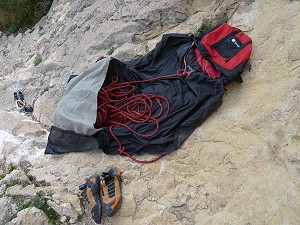
- Use a butterfly coil to avoid getting twists in your rope.
- If your rope is twisted let it hang free so that that the twists unravel.
- Make sure your rope is not exposed to any acids, especially battery acid in the back of your car.
- Don't mark your rope with felt tip pens, it can damage your rope.
- Don't step on your rope, it grinds dust and dirt into the sheath and core which reduces the life of a rope.
- Use a rope bag, again to protect from dirt and abrasive particles which will reduce the strength and performance of your rope. A rope bag is also convenient to carry your rope to the cliff and from one route to the next.
- Make sure when climbing that your rope doesn't run over sharp edges or pulls tight over rough rock then slides.
- If you take lots of falls, switch ends now and again and allow your rope to rest after a fall so that it regains its elasticity.
- Inspect your rope after each use by running through your hands. Look for nicks, cuts and abrasions of the sheath, and a soft mushy core.
- Wash your rope, depending on use after 40 or so uses.
- Store your rope in a cool and dry place away from chemicals either in a rope bag or hung up from a dowel.
- Replace your rope if damaged or old. A rough rule of thumb for when you retire a rope is:
- Heavy sport climbing use with repeated falls: 3-6 months
- Heavy trad climbing use with few falls: 1-2 years
- Weekends: 2-3 years
- Occasional use: 4-5 years
Other Rope Articles at UKC
Find out more about Sterling Rope at www.sterlingrope.com
Sterling Rope are distributed in the UK by Beta Climbing Designs.
Sterling Rope Stockists in the UK
- Lakes Climber
- Rock and Run
- Crag X
- The Climbing Works
- Rock On
- The Climbers Shop
- The Depot Climbing Centre
- George Fishers
- Dynamic Rock Adventures Ltd
- The Leeds Wall Shop
- Dick's Climbing
- Up and Under
Check stockists at www.betaclimbingdesigns.com
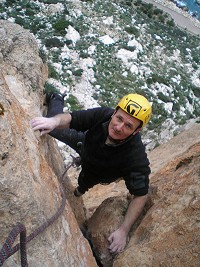
About Mick Ryan
Mick Ryan is the Senior Editor at UKClimbing.com. He has established over 100 new routes, many of them bolt routes, on Yorkshire and North Wales limestone in the UK, in Spain and in New Hampshire, California and Nevada in the USA. He established over 400 boulder problems around Bishop, California. He was author of the Yorkshire Limestone and Islands In the Sky a guidebook to climbing on Las Vegas and Great Basin Limestone with Dan McQuade and Randy Leavitt both published by Rockfax guidebooks, and is co-author, with Wills Young of Bishop Bouldering published by Wolverine Publishing .




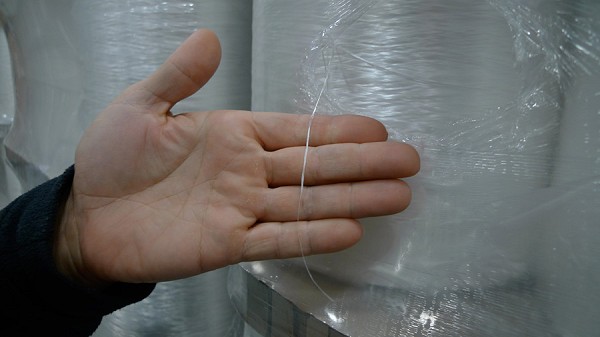
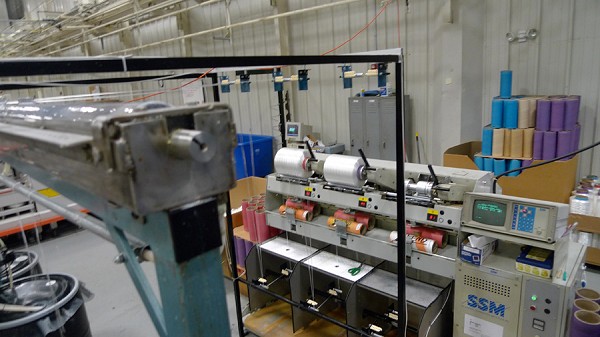
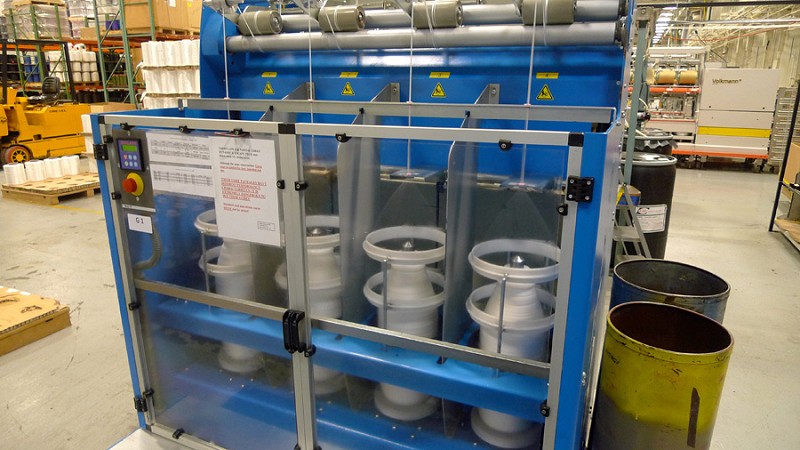
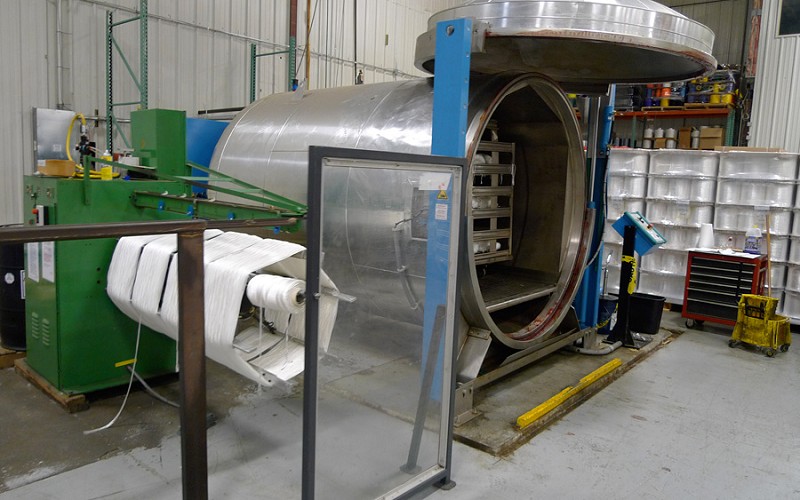
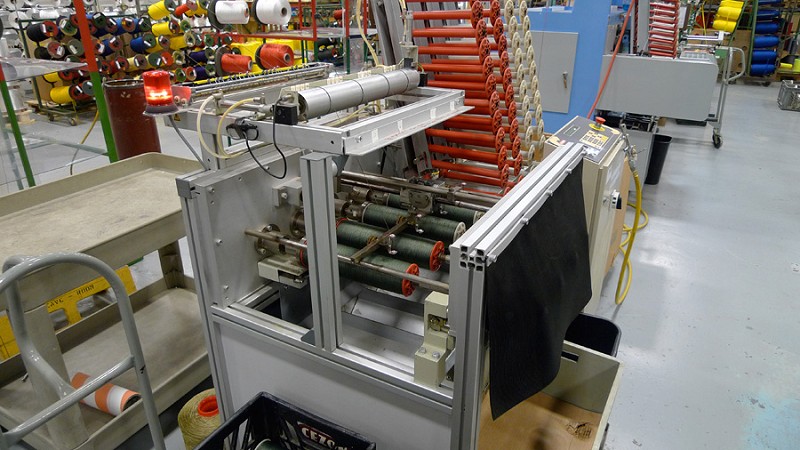







Comments